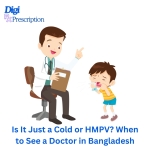
Is It Just a Cold or HMPV? When to See a Doctor in Bangladesh
In Bangladesh, respiratory illnesses are common, especially during winter and seasonal changes. While most cases of colds are mild and resolve on their own, Human Metapneumovirus (HMPV) can present similar symptoms but lead to more severe health issues, particularly for vulnerable groups. Knowing when to seek medical help is crucial for better outcomes.
This guide explains the differences between a common cold and HMPV, the risks, and when you should visit a doctor.
What is HMPV?
Human Metapneumovirus (HMPV) is a respiratory virus that affects people of all ages but is particularly dangerous for:
- Children under five years.
- Elderly individuals.
- People with weakened immune systems or chronic illnesses.
Symptoms of HMPV:
- Persistent cough.
- Wheezing or difficulty breathing.
- Nasal congestion.
- Fever (mild to moderate).
- Fatigue and irritability.
- Severe cases: Pneumonia or bronchitis.
What is a Common Cold?
The common cold is caused by various viruses, including rhinoviruses. It is typically mild and resolves within a few days without medical intervention.
Symptoms of a Common Cold:
- Sneezing.
- Runny or stuffy nose.
- Sore throat.
- Mild cough.
- Low-grade fever (less common).
- Fatigue or slight body aches.
Key Differences Between a Cold and HMPV
| Feature | Common Cold | HMPV |
|---|---|---|
| Cause | Rhinoviruses or other mild viruses | Human Metapneumovirus (HMPV) |
| Fever | Rare or mild (low-grade) | Common, mild to moderate |
| Respiratory Symptoms | Mild congestion, sneezing, slight cough | Persistent cough, wheezing, shortness of breath |
| Risk of Complications | Very low | High in children, elderly, and immunocompromised |
| Duration | 5–7 days | 1–2 weeks or longer (severe cases) |
When to See a Doctor in Bangladesh
For Children:
- Difficulty breathing or wheezing.
- Persistent high fever above 102°F (38.9°C).
- Inability to eat or drink properly.
- Signs of dehydration (dry mouth, no tears, reduced urination).
- Lethargy or unusual irritability.
For Adults:
- Shortness of breath or chest pain.
- High fever that doesn’t improve after 3 days.
- Persistent or worsening cough.
- Extreme fatigue that disrupts daily activities.
High-Risk Groups:
- Older adults with underlying conditions such as diabetes, asthma, or heart disease.
- Immunocompromised individuals (e.g., cancer patients, transplant recipients).
- Pregnant women experiencing respiratory symptoms.
Preventive Measures for Colds and HMPV
-
Practice Good Hygiene:
- Wash hands frequently with soap and water.
- Avoid touching your face, especially your eyes, nose, and mouth.
-
Wear a Mask in Crowded Areas:
- Particularly in public spaces like markets, buses, and hospitals.
-
Boost Immunity:
- Eat a balanced diet rich in vitamins and minerals.
- Stay hydrated and exercise regularly.
-
Keep Your Environment Clean:
- Disinfect commonly touched surfaces such as doorknobs, mobile phones, and countertops.
-
Vaccination and Regular Checkups:
- Consult your doctor about flu vaccinations and other preventive measures.
Diagnosis and Treatment
Diagnosis:
If you suspect HMPV, visit a healthcare provider. Diagnostic tests like PCR or rapid viral testing can confirm the virus.
Treatment for HMPV:
- Supportive care: Rest, hydration, and over-the-counter fever reducers.
- Severe cases: Oxygen therapy or hospitalization may be required.
Treatment for a Cold:
- Rest and plenty of fluids.
- Over-the-counter medications for symptom relief.
Why Timely Diagnosis Matters
HMPV can mimic symptoms of the common cold but escalate to severe conditions like pneumonia or bronchitis, especially in vulnerable groups. Early detection and treatment can prevent complications and reduce hospitalizations.
Conclusion
In Bangladesh, distinguishing between a common cold and HMPV is essential to safeguard health, especially during winter. By staying informed, practicing preventive measures, and seeking medical care when needed, you can protect yourself and your family from severe respiratory complications.
Reliable Sources of Information
- World Health Organization (WHO): WHO on Respiratory Illnesses
- Centers for Disease Control and Prevention (CDC): CDC on HMPV
- Directorate General of Health Services (DGHS), Bangladesh: DGHS Bangladesh
- icddr,b: Research on Infectious Diseases
